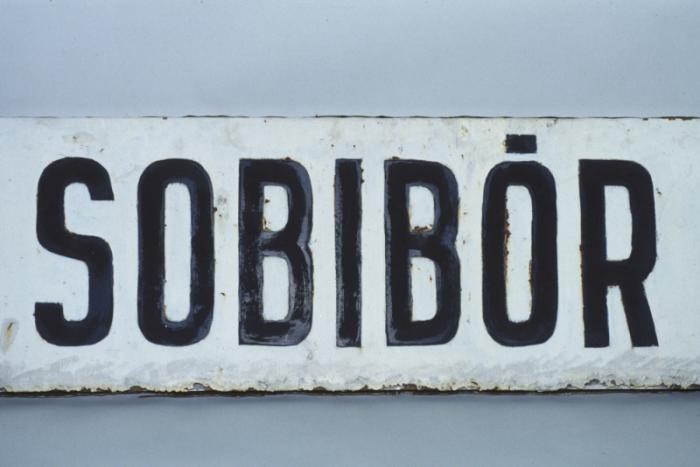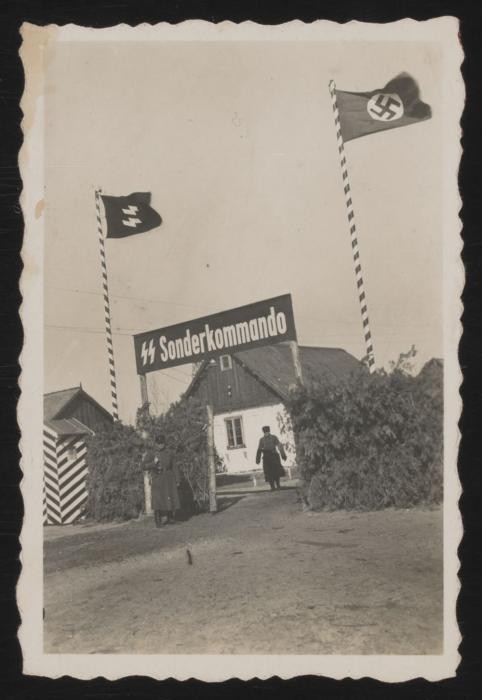
Sobibor: Key Dates
To carry out the mass murder of Europe's Jews, the SS established killing centers devoted exlusively or primarily to the destruction of human beings in gas chambers. Sobibor was among these killing centers. It was one of three killing centers linked to Operation Reinhard, the SS plan to murder almost two million Jews living in the German-administered territory of occupied Poland, called the General Government.

November 1, 1939–September 1943
On November 1, 1939, Heinrich Himmler appoints SS General Odilo Globocnik to the position of SS and Police Leader in Lublin District. Himmler is SS Chief and Chief of German Police. On July 17, 1941, he appoints Globocnik to the position of Commissioner for the Establishment of SS and Police Bases in the Occupied Eastern Territories. In early autumn of that year, Himmler tasks Globocnik with organizing the mass murder of Jews residing in the General Government (Generalgouvernement). This operation later becomes known as Operation Reinhard (also called Aktion Reinhard or Einsatz Reinhard). The effort was named after Reinhard Heydrich, who was assassinated in Prague in the spring of 1942. Heydrich was head of the Reich Security Main Office (RSHA) and a chief architect of the “Final Solution.” Three killing centers—Belzec, Sobibor, and Treblinka—are constructed for the sole purpose of killing Jews. Between March 1942 and November 1943, the personnel of Operation Reinhard kill approximately 1.7 million Jews in these three killing centers and related shooting operations.
March 1942–May 1942
Under the supervision of SS Captain Richard Thomalla, SS and police authorities construct the Sobibor killing center in the spring of 1942. The killing center is located not far from the local Lublin-Chelm-Wlodawa rail line. This is an isolated area located about 50 miles east of the city Lublin, 24 miles north of the town Chelm, and 5 miles south of the town Wlodawa. During the German occupation of Poland in World War II, this area was in the Lublin District of the General Government.
April 28, 1942
After the killing center is constructed, SS First Lieutenant Franz Stangl arrives in Sobibor. There, he takes up the position of camp commandant. Stangl was previously the deputy supervisor of the so-called "euthanasia" killing center at Hartheim, near Linz, Austria. The purpose of the “euthanasia” operation was to murder institutionalized persons with physical and mental disabilities. At facilities like Hartheim, gas chambers were used as a killing method. Thus, Stangl is familiar with using carbon monoxide gas to kill large numbers of people.
May 3, 1942
In early April 1942, the SS deports 2,400 Jews from the Rejowiec transit ghetto located in Chelm county within Lublin District. This is the first deportation to Sobibor. Almost all of the Jews brought to Sobibor on this transport are murdered upon arrival. Regular transports begin on May 3, with the arrival of 200 Jews from the city Zamosc. The camp staff conducts gassing operations in three gas chambers located in one brick building. Approximately 400 prisoners are selected to survive, but only temporarily. Those selected are used to supply the manual labor necessary to support the mass murder function of the killing center. During this first phase of deportations, from early May until the end of July 1942, the Sobibor killing center authorities kill at least 61,400 Jews. Many of the victims had been deported from cities and towns in the north and east of Lublin District. The majority were Jews deported from the German Reich, the Protectorate of Bohemia and Moravia, and Slovakia. They were deported either directly or via the transit camp-ghetto in Izbica, a village in Lublin District.
July 19, 1942
In Lublin, Himmler meets with Operation Reinhard manager Odilo Globocnik and with SS General Friedrich-Wilhelm Krüger. Krüger is the Higher SS and Police Leader for the General Government. The three men discuss the killing operations. Himmler orders the deportation and murder of all Jews in the General Government by the end of 1942. He euphemistically calls this process “resettlement.” An estimated 1,200,000 Jews reside in the General Government. Himmler's order accelerates the Operation Reinhard killing program.
Late July–September, 1942
At the end of July, the SS halts deportations to Sobibor in order to modernize the railway spur into the camp. During the two month lull in transports, the SS also reconstructs the existing gas chambers and adds new ones. A narrow railway trolley from the reception platform to the burial pits is also newly constructed.
October 1942
During the first week of October 1942, the camp authorities resume mass murder operations in the gas chambers of Sobibor. Between October 8 and October 20, more than 24,000 Slovak Jews are brought there from the transit camp-ghetto Izbica. The camp authorities kill virtually all of the deportees upon arrival in the reconstructed and newly added gas chambers. The gas chambers’ improved capacity enables the camp authorities to kill up to 1,300 people at a time. The new narrow railway trolley from the reception platform to the burial pits facilitates the transfer of the sick, the dead, and those unable to walk directly to the open ovens. Those still alive after this journey are shot by the SS staff or the Trawniki-trained guards.
March 5, 1943
German SS and police authorities begin deportations of Dutch Jews from the police transit camp at Westerbork in the Netherlands to Sobibor. In 19 transports from this date until July 1943, SS authorities in Westerbork deport over 34,000 Jews to Sobibor. Camp staff and guards kill almost all of them in the gas chambers or by shooting them on arrival.
April 1943
Two transports containing a total of 2,000 Jews from France arrive at Sobibor from the police transit camp Drancy, outside Paris. Deportations from France to camps in the east—primarily Auschwitz—began in March 1942. These deportations will continue until August 1944.
July–October 1943
In July 1943, Himmler orders the liquidation of the ghettos in Reichskommissariat Ostland. SS and police units liquidate ghettos in Minsk, Lida, and Vilna. They deport those who survive to Sobibor. The first transports from Minsk and Lida leave for Sobibor on September 18. Included in the first deportation is Alexander Pechersky, a Soviet prisoner of war (POW). Pechersky had been transferred to the Minsk ghetto because he was Jewish. Because of his military training, he was to play a central role in the resistance movement in Sobibor. In September 1943 alone, SS and police authorities transport at least 13,700 Jews from ghettos in the occupied Soviet Union to Sobibor. The camp authorities gas or shoot most of them upon arrival.
October 14, 1943
Prisoners carry out a revolt in Sobibor. They kill nearly a dozen German staff and Trawniki-trained guards. Of 600 prisoners left in Sobibor on this day, 300 escape during the uprising. Among the survivors is Alexander Pechersky, the Soviet POW who played a key role in planning the revolt. Of those prisoners who escape, SS and police personnel from Lublin district recapture and shoot some 100 prisoners. Some 50 prisoners survive the end of the war.
November 4, 1943–January 5, 1944
In correspondence with Heinrich Himmler, Odilo Globocnik files final reports. They detail the conclusion of Operation Reinhard and the dismantling of the killing centers. The reports also describe the accounting of the possessions, currency, and valuables stolen from the murdered victims. Within the framework of Operation Reinhard, which included three killing centers and a number of mass shootings, the SS and police kill approximately 1.7 million people.

